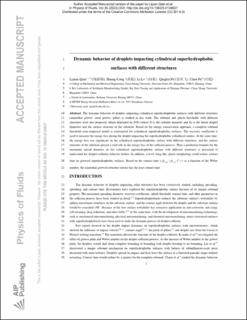Dynamic behavior of droplets impacting cylindrical superhydrophobic surfaces with different structures
Peer reviewed, Journal article
Accepted version
Permanent lenke
https://hdl.handle.net/11250/3109625Utgivelsesdato
2023Metadata
Vis full innførselSamlinger
- Publikasjoner fra CRIStin - SINTEF Energi [1632]
- SINTEF Energi [1756]
Originalversjon
10.1063/5.0134637Sammendrag
The dynamic behavior of droplets impacting cylindrical superhydrophobic surfaces with different structures (azimuthal groove, axial groove, pillar) is studied in this work. The rebound and splash thresholds with different structures were also proposed, which depended on D/D0 (where D is the cylinder diameter and D0 is the initial droplet diameter) and the surface structure of the substrate. Based on the energy conservation approach, a complete rebound threshold semi-empirical model is constructed for cylindrical superhydrophobic surfaces. The recovery coefficient is used to measure the energy loss during the droplet impacting the superhydrophobic cylindrical surface. At the same time, the energy loss was significant on the cylindrical superhydrophobic surface with different structures, and the surface structure of the substrate played a vital role in the energy loss of the collision process. Then, a prediction formula for the maximum spread diameter on the cylindrical superhydrophobic surface with different structures is presented to understand the droplet collision behavior further. In addition, a level wing-like splash morphology could reduce contact time on grooved superhydrophobic surfaces. Based on the contact time [(β a max / β z max) 1 / 2 τ] as a function of the Weber number, the azimuthal grooved structure surface has the least contact time. © 2023 Author(s). Dynamic behavior of droplets impacting cylindrical superhydrophobic surfaces with different structures

